“If a young Soviet woman patriot is burning to master the machine gun, we should give her the opportunity to realize her dream. If a young Soviet woman wants to become a sniper, we should not discourage her desires.”
— Pravda, 1942
Despite numerous steps towards equality in the past century, there remains only one military theater which has seen large numbers of female soldiers take part, in many areas on an equal footing with their male counterparts. This took place in World War II, on the front between the Nazis and Soviet forces in Eastern Europe, where it’s estimated that more than three-quarters of a million women served on the Russian side. Around 200,000 were decorated for their efforts, with 89 receiving the highest honour, being awarded the Hero of the Soviet Union. It was not so much a philosophical choice by those in charge, as much as one necessitated by expediency.
When the Germans first attacked in 1941, women who attempted to volunteer were turned down, but the Russian forces suffered such a hellacious level of losses that any such restrictions were soon loosened. This echoed a similar situation which had occurred in the later stages of the First World War. After the Russian Revolution got under way in early 1917, fifteen women’s formations were created, such as the charmingly-named “1st Russian Women’s Battalion of Death”. During the Kerensky Offensive, they went over the top into enemy territory when their war-weary male counterparts were reluctant to do so, capturing at least temporarily, a swathe of enemy territory, and were praised for their courage. However, they faced increasing hostility from the men, and the battalions were dissolved after less than a year.
25 years later, women were in particular used as snipers and pilots, but served across virtually the entire range of military fields, including as machine gunners, tank drivers, medics, communication personnel, and on anti-aircraft batteries. There is an issue in terms of verifiable historical data: most of the evidence for and reports on these soldiers, comes solely from the Soviet side. It’s not cynical to think the stories may quite possibly have been exaggerated or fabricated, to varying extents, in the interests of wartime propaganda. However, for the purposes of the rest of this article, we won’t bother trying to separate the legend from the facts: after all, the former are likely to be far more entertaining! So let’s take a look at some of the most-renowned women soldiers to take up arms against the Third Reich on the Russian front.
Snipers
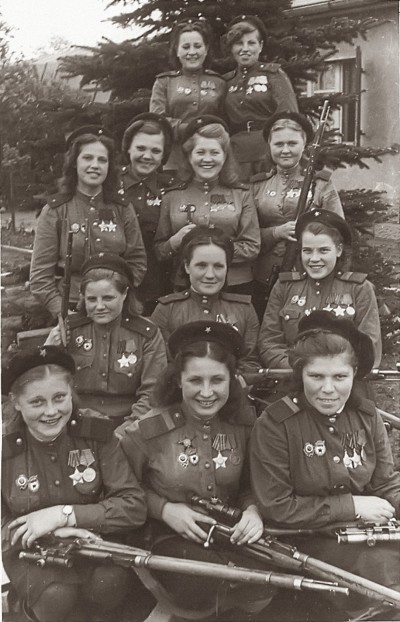 The Russians found women to be particularly suited to the job of sniper: the traits required Major General Morozov, “the father of the sniper movement”, was quoted as saying that “a woman’s hand is more sensitive than is a man’s. Therefore when a woman is shooting, her index finger pulls the trigger more smoothly and purposefully”. By 1943, there were over two thousand female snipers in the military, with more than 12,000 confirmed kills between them. The photo on the right, taken in Germany in May 945, shows a dozen members of the 3rd Shock Army, 1st Belorussian Front, who racked up 775 kills between them, led by Guard Lieutenant VI Artamonov – second row down, second from the right, who had 89. But that tally pales beside the queen of all Soviet sharpshooters.
The Russians found women to be particularly suited to the job of sniper: the traits required Major General Morozov, “the father of the sniper movement”, was quoted as saying that “a woman’s hand is more sensitive than is a man’s. Therefore when a woman is shooting, her index finger pulls the trigger more smoothly and purposefully”. By 1943, there were over two thousand female snipers in the military, with more than 12,000 confirmed kills between them. The photo on the right, taken in Germany in May 945, shows a dozen members of the 3rd Shock Army, 1st Belorussian Front, who racked up 775 kills between them, led by Guard Lieutenant VI Artamonov – second row down, second from the right, who had 89. But that tally pales beside the queen of all Soviet sharpshooters.
Lyudmila Pavlichenko
“I wear my uniform with honor. It has the Order of Lenin on it. It has been covered with blood in battle. It is plain to see that with American women what is important is whether they wear silk underwear under their uniforms. What the uniform stands for, they have yet to learn.”
— Pavlichenko
Pavlichenko was credited with 309 confirmed kills. Let’s put that into perspective. In all of Kill Bill, the Bride killed only 70 people, less than one-quarter of those who fell victim to Pavlichenko. Even Chris Kyle, the hero of American Sniper, barely reached half her tally, using far more advanced weaponry. And her count may be low. A skeptical Red Army unit insist she proved her prowess, pointing her at two Romanians working with the Germans. When she took them down, she was accepted, but didn’t include them in her official tally, “because they were test shots.” But when she entered actual battle conditions, she froze, until the young soldier next to her was killed. The incident shocked her into action, and she took out two German scouts that same day.
A hundred of her subsequent victims were Nazi officers, and another 36 were snipers working for the other side, taken out in lengthy battles that could last as long as three days and required her to stay in one spot without moving for up to 20 hours. Wounded four times, she was eventually withdrawn from the front, becoming instead a trainer of other snipers and also going on morale-boosting and political trips. These included a 1942 sojourn to America and the United Kingdom, where she became the first Soviet citizen to be officially welcomed at the White House. Unlike many of her colleagues, she made it through the war alive, and after hostilities ended, finished her education and took up a position as a research assistant at the Soviet Navy’s headquarters. She died in 1974, at the age of 58.
Folk singer Woody Guthrie wrote a song inspired by her: “In the mountains and canyons, quiet as the deer/Down in the forest knowing no fear/Lift up your sight, down comes a Hun/Three hundred Nazis fell by your gun.” And in February this year, a film inspired by Pavlichenko’s life was released. The Russian-Ukrainian co-production was called Battle for Sevastopol in Russia, and Indestructible in the Ukraine, and was filmed just before relations between the two countries went south. According to reports, “As played by Yulia Peresild, the film’s heroine is unsmiling and unremittingly tough. “War’s no place for cowards,” she says. She vows to “kill 100 enemies”, hugging her rifle, and upbraids a fellow sniper for firing a shot to finish off a Nazi dying in agony. “They don’t deserve an easy death,” she says.” Here’s the trailer; no subs, but it’s one for which we’ll certainly keep an eye out.
Nina Alexeyevna Lobkovskaya
Nina’s willingness to join the army became a burning desire after her father, a machine-gunner was killed fighting the Germans. She wrote in her memoirs, “Hatred for the enemy that was causing so much human suffering choked me. That hatred cemented my resolution to join the army.” Initially serving as a nurse, in October of 1942, the 17-year-old girl was accepted into the women’s sniper school, near Moscow, along with almost three hundred others. After nine months of training, she was sent to the Kalinin front, and was soon achieving renown for her skills, a regimental newspaper writing, “Nina Lobkovskaya has a sharp eye and steady hand. Her rifle never misses.” In 1944, Lobkovskaya was wounded, but ran away from hospital to rejoin her unit and continue fighting. She was still only 20 by the time the war had ended, but was credited with 89 kills.
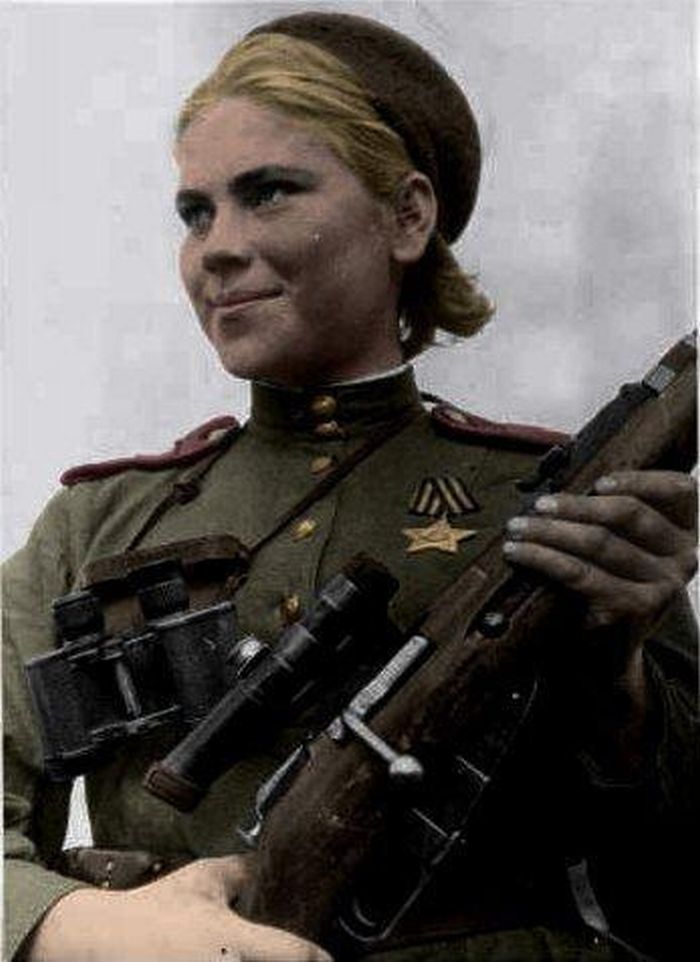 Roza Yegorovna Shanina
Roza Yegorovna Shanina
If there was a pin-up girl for Soviet snipers, Shanina (shown atop this article) would probably be it. Though her tally – a “mere” 59 confirmed victims – was not among the highest, her character and heroic character have resonated through the subsequent decades. Her strong personality was apparent well before the war: at age 14, she walked 120 miles to study at college, against the wishes of her parents. After her brother was killed in action in December 1941,. she asked to join the military, but she was not accepted until June 1943. She graduated with honours, and joined the 184th Rifle Division the following April, being appointed commander of a female sniper group. Barely two weeks later, she was awarded her first military decoration, the Order of Glory 3rd Class, having taken out 13 members of the enemy while under fire.
Even after her platoon was disbanded and snipers were withdrawn, Roza persisted: when her request to be returned to the front was refused, she went anyway [she was reprimanded, but avoided formal sanction] Her renown even reached the West, including her photo in the Washingtom Times-Herald and an AP report in September 1944 describing her as “the unseen terror of East Prussia”, citing a Red Army report describing how she sniped five Nazis in a single incident. Shanina was wounded in the shoulder by enemy fire in December, but persisted in efforts to obtain official sanction for service at the front. She finally obtained it on January 8, 1945, but wouldn’t survive the month. While shielding an injured officer, Roza was hit by a shell fragment, and died the following day. She was about two months shy of turning 21.
However, Shanina had – in disregard of regulations – kept a diary over the last few months of her life. This record of her war, along with a large number of letters she had written to friends and relations, were published in the mid-sixties and rekindled interest in this Soviet heroine.
Pilots
The air was another field of war where women could take part on an almost equal footing with men, physical strength not being a major requirement. Indeed, even before war broke out, Russia had the likes of Marina Raskova, who had become a navigator in the Air Force as early as 1933, and was the first woman to teach at the Zhukovskii Air Academy. After the war started, Raskova convinced Joseph Stalin to form three combat groups for women – not just women pilots, but also with female ground support personnel. From 1942 through the war’s end, they flew over thirty thousand combat missions, with over thirty members becoming Heroes of the Soviet Union. That included Raskova herself, who commanded one of the units, the 125th Guards Bomber Aviation Regiment, until her death in a plane crash.
The “Night Witches”
“We bombed, we killed; it was all a part of war. We had an enemy in front of us, and we had to prove that we were stronger and more prepared.”
— Nadezhda Popova
Nachthexen was the perjorative nickname given by the Germans to the 588th Night Bomber Regiment. This was the result of their tactic of switching off their engines in order to glide up unheard and deliver their payload on the target, with the noise of the wind whistling in their wings supposedly like the sound of witches’ broomsticks! The group had to rely on stealth tactics, as their planes were slow and outdated Polikarpov Po-2’s, intended for us as training craft and crop-dusting. However, their very slowness gave them a tactical advantage, as they could fly at speeds of less than 100 mph, where enemy planes like the Messerschmitt Bf 109 would stall out and fall from the sky.
The main tactic used was to fly in groups of three: two would operate as decoys, drawing the fire of anti-aircraft guns, while the third made its bombing pass. It would then swap places with one of the decoys, until all the planes had delivered their lethal cargo. They were so accurate, the Germans spread rumours that the women pilots had been injected with drugs to give them cat-like night vision. But their stamina was equally tested: the limited capacity of the planes often forced them to fly fifteen or more sorties per night, often under heavy fire. Their craft had no radios, no radar, and the pilots didn’t bother with parachutes, because the low altitude at which they operated would have rendered them useless.
One such pilot was Nadezhda Popova, who was born in the Ukraine, and whose life was changed one day when a plane landed near her home. She said, “I had thought only gods could fly. It was amazing to me that a simple man could get in a plane and fly away.” Nadezhda secretly signed up at a gliding school as a 15-year-old, and made her first solo flight and parachute jump the following year. Popova joined up, having lost both her brother and the family home to the war and flew a total of 852 missions, including on one occasion, eighteen in a night. She was shot down multiple times, but always survived, and had numerous other close brushes with death. After one mission, she counted 42 bullet holes in her plane and told her navigator, “Katya, my dear – we will live long.” She wasn’t wrong: Popova made it through the war and for almost seven decades after, dying only a couple of years ago, at the age of 92.
There was, at one point, plans for an Anglo-Canadian-Russian co-production inspired by the squadron, starring Malcolm McDowell, Anna Friel and Sophie Marceau, to be directed by Alexander Siddig, but funding for that fell through. Below, is a documentary (in six parts) on the Night Witches, along with a special bonus, the 1981 Russian feature, В небе ночные ведьмы (Night Witches In The Sky). The former has subs; the latter, unfortunately, doesn’t but still shows you the kind of planes they were flying. It was directed by Evgenia Zhigulenko, one of the members of the 588th, who was awarded the Hero of the Soviet Union decoration for her exploits, so one imagines it’s likely to be fairly accurate.
Lydia Litvyak and Yekaterina Budanova
The term “ace” in regard to fighter pilots is not a vague term: it means someone who has achieved five or more confirmed takedowns of enemy planes. Litvyak and Budanova are the only female fighter aces in the history of flight. Litvyak had 12 solo kills (plus 2 or 4 shared, depending on the source), while Budanova had 11 air victories, six as an individual and five shared; for a while, they were comrades as part of the 586th Fighter Regiment. Litvyak, known as the “White Lily of Stalingrad”, allegedly after the flower painted on the side of her fuselage. When war broke out, she was already a flight instructor, but didn’t have the necessary experience to enlist and become a fighter pilot. So she cooked the books, adding 100 hours on to her logged time, and was accepted.
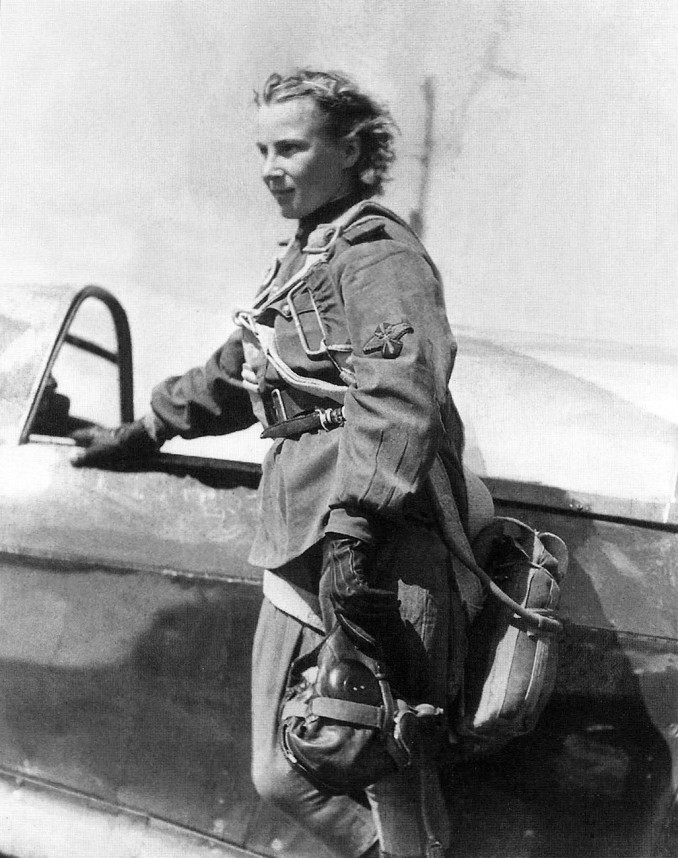 She shot down her first two victims on September 13, 1942. The second was a German ace himself, with 11 kills, Erwin Maier. After being captured, Maier asked to meet the pilot responsible: when introduced to Litvyak, he thought it was some kind of joke, until she described their dog-fight in detail. She always had a rebellious streak, and on returning from successful missions, would engage in aerobatics over the base, knowing that it irritated her commanding officer. But she had a feminine side as well, and seems to have been in a relationship with fellow ace Alexei Solomatin. When he was killed, she wrote to her mother, “He was not my type, but his insistence and his love for me convinced me to love him”. Litvyak’s fate remains uncertain: she’s generally regarded to have been shot down and killed during a vicious air-battle in August 1943, but some speculate she survived the landing, was captured by the Germans, and moved to Switzerland after the war. Presuming the former, she was posthumously awarded Hero of the Soviet Union by Mikhail Gorbachev in 1990.
She shot down her first two victims on September 13, 1942. The second was a German ace himself, with 11 kills, Erwin Maier. After being captured, Maier asked to meet the pilot responsible: when introduced to Litvyak, he thought it was some kind of joke, until she described their dog-fight in detail. She always had a rebellious streak, and on returning from successful missions, would engage in aerobatics over the base, knowing that it irritated her commanding officer. But she had a feminine side as well, and seems to have been in a relationship with fellow ace Alexei Solomatin. When he was killed, she wrote to her mother, “He was not my type, but his insistence and his love for me convinced me to love him”. Litvyak’s fate remains uncertain: she’s generally regarded to have been shot down and killed during a vicious air-battle in August 1943, but some speculate she survived the landing, was captured by the Germans, and moved to Switzerland after the war. Presuming the former, she was posthumously awarded Hero of the Soviet Union by Mikhail Gorbachev in 1990.
There’s some suggestion that Budanova may have had more kills than Litvyak. She was a smart young woman, who was top of her class in elementary school, but had to give up her education and help support her family after her father died. A job as a carpenter in an aircraft factory awakened her interest in flying, and she got her pilot’s license at age 18, becoming an instructor three years later. After war with Germany broke out in the summer of 1941, she joined the military and was assigned to the 586th. After proving themselves in air battle, the top pilots from the squadron, including both Budanova and Litvyak, were re-assigned to the 437th IAP, on the banks of the Volga. By the end of 1942, Budanova had been further promoted, to the elite 9th Guards Fighter Regiment, consisting entirely of top pilots. But she would not survive the war: her mechanic, Inna Pasportnikova, gave this account of her final battle:
“She spotted three Messerschmitt going on the attack against a group of bombers. Katia attacked and diverted the enemy. A desperate fight developed in the air. Katia managed to pick up an enemy aircraft in her sight and riddle him with bullets. This was the fifth aircraft she killed personally. Katia’s fighter rapidly soared upward and swooped down on a second enemy aircraft. She “stitched” it with bullets, and the second Messer, streaming black smoke, escaped to the west. But Katia’s red starred fighter had been hit; tongues of flame were already licking at the wings.”
Tank commanders
Aleksandra Samusenko
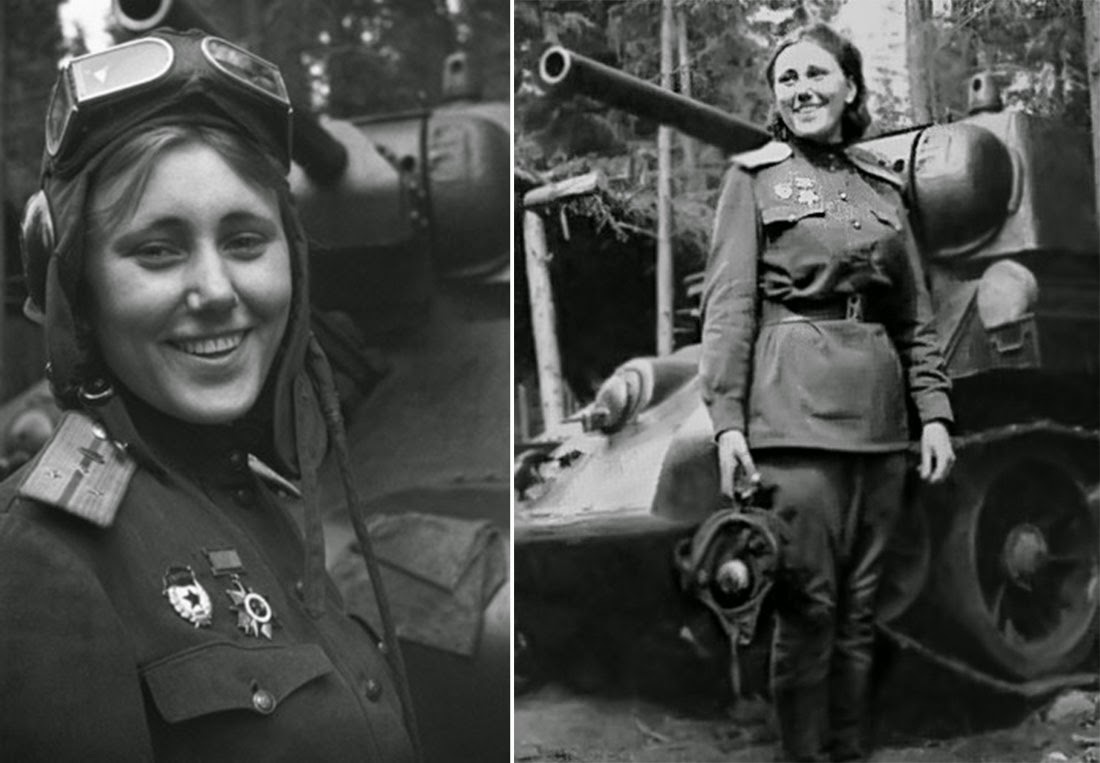 Originally a private in the infantry, Samusenko won the Order of the Red Star in the Battle of Kursk, the largest tank battle in history, for a fight where she and her T-34 tank defeated three German tiger tanks in an encounter lasting several hours. Later in the war, when her commanding officer was killed, she took over and led her group out of an ambush. She also fought alongside US Army Sergeant Joseph Beyrle, who had escaped from a German POW camp in January 1945, and encountered Samusenko’s group while on the run. Beyrle convinced Samusenko he was legitimate by demonstrating he knew demolitions work, and he became the only American to serve in World War 2 with both the US and Soviet Armies; he helped liberate the POW camp in which he had been held! Unfortunately, there was no such happy ending for Samusenko, who was reportedly crushed to death by another Soviet tank in March 1945. She had reached the rank of Captain.
Originally a private in the infantry, Samusenko won the Order of the Red Star in the Battle of Kursk, the largest tank battle in history, for a fight where she and her T-34 tank defeated three German tiger tanks in an encounter lasting several hours. Later in the war, when her commanding officer was killed, she took over and led her group out of an ambush. She also fought alongside US Army Sergeant Joseph Beyrle, who had escaped from a German POW camp in January 1945, and encountered Samusenko’s group while on the run. Beyrle convinced Samusenko he was legitimate by demonstrating he knew demolitions work, and he became the only American to serve in World War 2 with both the US and Soviet Armies; he helped liberate the POW camp in which he had been held! Unfortunately, there was no such happy ending for Samusenko, who was reportedly crushed to death by another Soviet tank in March 1945. She had reached the rank of Captain.
Mariya Oktyabrskaya
“My husband was killed in action defending the motherland. I want revenge on the fascist dogs for his death and for the death of Soviet people tortured by the fascist barbarians. For this purpose I’ve deposited all my personal savings – 50,000 rubles – to the National Bank in order to build a tank. I kindly ask to name the tank ‘Fighting Girlfriend’ and to send me to the front-line as a driver of said tank.”
So wrote Oktyabrskaya to Stalin in 1943, and the State Defense Committee took her up on the offer, although it was initially seen as no more than a morale-boosting publicity stunt. However, Oktyabrskaya completed the five months training, and when she entered the fray in October that year, her courage and skill proved she was more than propaganda. She developed a fearless reputation, not least for leaping out to repair her tank (which indeed had “Fighting Girlfriend” painted on the side of the barrel, per her request!) after it had been hit and disabled by enemy fire. However, that proved to be her undoing, as during one such mechanical foray, during a January 1944 battle near Vitebsk, she was hit in the head by a shell fragment. While Mariya lingered on for two months, she never regained consciousness, and was posthumously awarded Hero of the Soviet Union in August, at the age of 38.
They also served…
Orphaned at age 11, Nina Onilova was inspired in her chosen military field by seeing the 1934 film Chapaev, which included the character of a woman machine-gunner called Anka. She was originally in the army as a medic, but while tending to the wounded during a battle, she helped a machine-gun post fix their jammed weapon and took over handling it, mowing down the enemy. Recognizing a good thing when they saw it, the crew took her on as their permanent gunner. Shortly after, she was hurt in a mortar blast and spent two months in hospital, until the doctors got tired of her demands to be returned to the front, and released her. Back in action, she single-handedly took out a German tank – without a machine-gun, using Molotov cocktails – earning the Order of the Red Banner and the rank of Sergeant. She was killed during a night battle in February 1942, in which she had already taken out a pair of enemy machine-gun positions and was covering the withdrawal of her fellow soldiers.
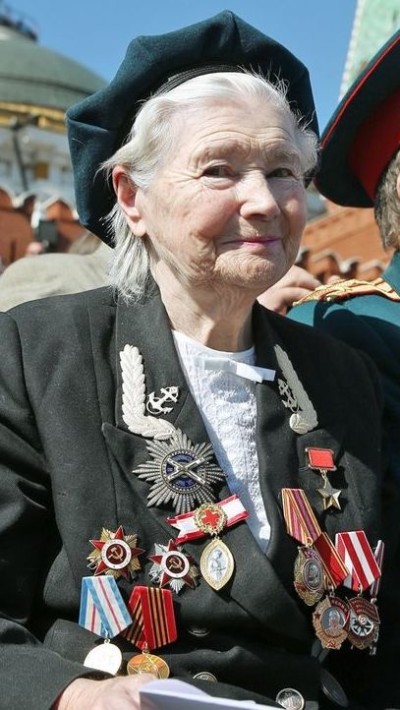 A group mention goes to the women of the 1077th Anti-Aircraft Regiment, who were part of the defenses around the city of Stalingrad, which witnessed among the most vicious fighting of the war as the Nazis mounted an effort to take over the city in August 1942. Made up almost entirely of young, local volunteers, barely out of high-school, they were left as the last line of defense against the advancing 16th Panzer Division. With little support, and mostly by dropping their anti-aircraft batteries to the horizontal, the regiment held off the Germans for two days. The official war records indicate they “destroyed or damaged 83 tanks and 15 other vehicles carrying infantry, destroyed or dispersed over three battalions of assault infantry, and shot down 14 aircraft” before eventually being over-run and wiped out.
A group mention goes to the women of the 1077th Anti-Aircraft Regiment, who were part of the defenses around the city of Stalingrad, which witnessed among the most vicious fighting of the war as the Nazis mounted an effort to take over the city in August 1942. Made up almost entirely of young, local volunteers, barely out of high-school, they were left as the last line of defense against the advancing 16th Panzer Division. With little support, and mostly by dropping their anti-aircraft batteries to the horizontal, the regiment held off the Germans for two days. The official war records indicate they “destroyed or damaged 83 tanks and 15 other vehicles carrying infantry, destroyed or dispersed over three battalions of assault infantry, and shot down 14 aircraft” before eventually being over-run and wiped out.
Ekaterina Mikhailova-Demina was the only woman to perform front-line reconnaissance for the Soviet marines during World War II. Like Onilova, she lost her parents early [it appears any Russian remake of Annie would have some spectacularly bad-ass orphans!], and volunteered at age 15, lying about her age to get accepted. Also like Onilova, she initially served as a medic, but found work behind the lines boring, and applied to join the marines. In February 1943, she became part of the 369th Independent Naval Infantry Battalion. August the next year saw her receive her first Order of the Red Banner for an assault where she single-handedly assaulted a fortified German position, taking 14 prisoners. She received a second Red Banner in December, for a Croation mission where three-quarters of her platoon were wiped out. Let’s end on a happy note. Unlike many of the women profiled here, Ekaterina survived the war – and, indeed, is still apparently living today, at age 89. Judging by the picture on the right, taken in 2013, she looks like she would still be happy to kick your ass!






